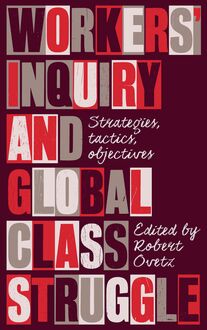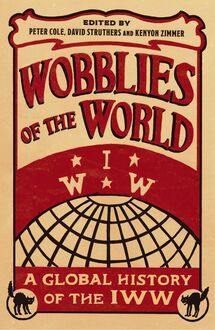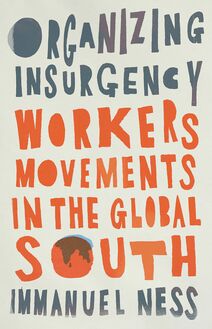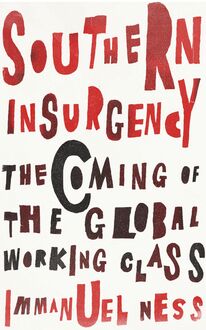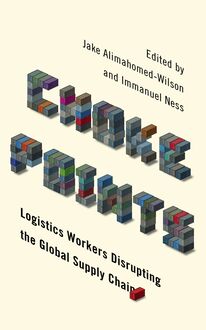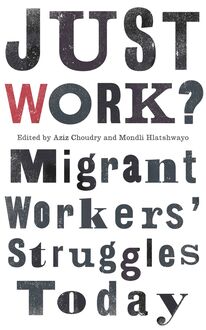-
 Univers
Univers
-
 Ebooks
Ebooks
-
 Livres audio
Livres audio
-
 Presse
Presse
-
 Podcasts
Podcasts
-
 BD
BD
-
 Documents
Documents
-
- Cours
- Révisions
- Ressources pédagogiques
- Sciences de l’éducation
- Manuels scolaires
- Langues
- Travaux de classe
- Annales de BEP
- Etudes supérieures
- Maternelle et primaire
- Fiches de lecture
- Orientation scolaire
- Méthodologie
- Corrigés de devoir
- Annales d’examens et concours
- Annales du bac
- Annales du brevet
- Rapports de stage
La lecture à portée de main
Vous pourrez modifier la taille du texte de cet ouvrage
Découvre YouScribe en t'inscrivant gratuitement
Je m'inscrisDécouvre YouScribe en t'inscrivant gratuitement
Je m'inscrisEn savoir plus
Vous pourrez modifier la taille du texte de cet ouvrage
En savoir plus

Description
Immanuel Ness looks at three key countries: China, India and South Africa. In each case he considers the broader historical forces at play - the effects of imperialism, the decline of the trade union movement, the class struggle and the effects of the growing reserve army of labour. For each case study, he narrows his focus to reveal the specifics of each grassroots insurgency: export promotion and the rise of worker insurgency in China, the new labour organisations in India, and the militancy of the miners in South Africa.
This is a study about the nature of the new industrial worker in the Global South; about people living a terrifying, precarious existence - but also one of experimentation, solidarity and struggle.
List of Maps, Figures and Tables
Preface and Acknowledgements
1. Introduction: The New International Working Class
Part I: Capitalism and Imperialism
2. The Industrial Proletariat of the Global South
3. Migration and the Reserve Army of Labor
Part II: Case Studies
4. India: Neoliberal Industrialization, Class Formation and Mobilization
5. China: State Capitalism, Foreign Investment and Worker Insurgency
6. South Africa: Post-Apartheid Labor Militancy in the Mining Sector
Conclusion
Notes
Index
Sujets
Informations
| Publié par | Pluto Press |
| Date de parution | 20 octobre 2015 |
| Nombre de lectures | 0 |
| EAN13 | 9781783717095 |
| Langue | English |
| Poids de l'ouvrage | 1 Mo |
Informations légales : prix de location à la page 0,0748€. Cette information est donnée uniquement à titre indicatif conformément à la législation en vigueur.
Extrait
SOUTHERN INSURGENCY
Wildcat: Workers’ Movements and Global Capitalism
Series Editors:
Peter Alexander (University of Johannesburg) Immanuel Ness (City University of New York) Tim Pringle (SOAS, University of London) Malehoko Tshoaedi (University of Pretoria)
Workers’ movements are a common and recurring feature in contemporary capitalism. The same militancy that inspired the mass labor movements of the twentieth century continues to define worker struggles that proliferate throughout the world today.
For more than a century labor unions have mobilized to represent the political-economic interests of workers by uncovering the abuses of capitalism, establishing wage standards, improving oppressive working conditions, and bargaining with employers and the state. Since the 1970s, organized labor has declined in size and influence as the global power and influence of capital has expanded dramatically. The world over, existing unions are in a condition of fracture and turbulence in response to neoliberalism, financialization, and the reappearance of rapacious forms of imperialism. New and modernized unions are adapting to conditions and creating class-conscious workers’ movement rooted in militancy and solidarity. Ironically, while the power of organized labor contracts, working-class militancy and resistance persists and is growing in the Global South.
Wildcat publishes ambitious and innovative works on the history and political economy of workers’ movements and is a forum for debate on pivotal movements and labor struggles. The series applies a broad definition of the labor movement to include workers in and out of unions, and seeks works that examine proletarianization and class formation; mass production; gender, affective and reproductive labor; imperialism and workers; syndicalism and independent unions, and labor and Leftist social and political movements.
Also available:
Just Work?: Migrant Workers’ Struggles Today
Edited by Aziz Choudry and Mondli Hlatshwayo
Southern Insurgency
The Coming of the Global Working Class
Immanuel Ness
First published 2016 by Pluto Press 345 Archway Road, London N6 5AA
www.plutobooks.com
Copyright © Immanuel Ness 2016
The right of Immanuel Ness to be identified as the author of this work has been asserted by him in accordance with the Copyright, Designs and Patents Act 1988.
British Library Cataloguing in Publication Data A catalogue record for this book is available from the British Library
ISBN 978 0 7453 3600 8 Hardback ISBN 978 0 7453 3599 5 Paperback ISBN 978 1 7837 1708 8 PDF eBook ISBN 978 1 7837 1710 1 Kindle eBook ISBN 978 1 7837 1709 5 EPUB eBook
This book is printed on paper suitable for recycling and made from fully managed and sustained forest sources. Logging, pulping and manufacturing processes are expected to conform to the environmental standards of the country of origin.
Typeset by Curran Publishing Services Text design by Melanie Patrick Simultaneously printed by CPI Antony Rowe, Chippenham, UK and Edwards Bros in the United States of America
Contents
List of Maps, Figures, and Tables
Preface and Acknowledgments
Introduction The New International Working Class
Part I Capitalism and Imperialism
Chapter 1 The Industrial Proletariat of the Global South
Chapter 2 Migration and the Reserve Army of Labor
Part II Case Studies
Chapter 3 India: Neoliberal Industrialization, Class Formation, and Mobilization
Chapter 4 China: State Capitalism, Foreign Investment, and Worker Insurgency
Chapter 5 South Africa: Post-Apartheid Labor Militancy in the Mining Sector
Conclusion
Notes
Index
Maps, figures, and tables
Maps
4.1 India, with a focus on Haryana State
5.1 China, with a focus on the Pearl River Delta
6.1 South Africa, with a focus on the North West
Figures
1.1 International comparison of hourly labor costs in the textile industry, 2011
1.2 Labor costs in manufacturing industries in selected countries, 2012
1.3 Hourly manufacturing wage in selected countries, 2012
1.4 Hourly compensation costs in manufacturing in selected countries, 2009
3.1 Number of international migrants, 1960–2000
5.1 Actual and projected average annual rate of change of China’s population, 1950–2015
5.2 Percentage of population residing in urban areas in China, by major area, five-year averages based on mid-year figures, 1950–2050
5.3 Employment growth in urban areas of China, 2009–13
5.4 ACFTU membership 1952–2012
Tables
1.1 Total male and female employment by sector, world, and regions
1.2 Value added by activity in 2010
2.1 FDI inflows and outflows by major regions, 1990–2013
2.2 FDI inflows and outflows by major regions, 1990–2013 (percentage share of total)
2.3 Gross fixed capital formation of developing countries
2.4 FDI inflows as percentage of gross fixed capital formation, 1990–2013
2.5 Labor share of national income around the world
2.6 Capital share of national income around the world, 2008
2.7 Mergers and acquisitions as share of FDI inflows in developing countries
2.8 Number of greenfield FDI projects by destination, 2003–13, share of total
2.9 International trade union membership
2.10 Trade union density rates and indlices of membership composition in the European Union
3.1 Indicators of the stock of international migrants by major area, 1960–2000
4.1 Indian major union organizations
4.2 Strikes at vehicle manufacturing plants in India, 2009–13
4.3 Worker grievances at Maruti Suzuki, Manesar Plant
5.1 China exports and imports, 1952–2012
5.2 China exports by product category, 2012
6.1 South African trade unions
Preface and Acknowledgments
This book is informed by national and comparative studies of labor movements in the contemporary era. The overwhelming evidence suggests that existing labor structures are unable to challenge the hegemony of international capital, global production and commodity chains, and the oppression of the neoliberal state. This is not to say that organized labor has ever possessed a persistent power over capital, aside from interregna of revolution and ephemeral worker rebellions. The book suggests that the working class and peasants can only achieve a modicum of institutional and structural power and dignity inside the modern capitalist state. A central premise is that the early 21st century has vastly and irreversibly altered the geographic location of the working class to the Global South, where the majority of the world’s population resides. The geographic location of the working class has followed in the tracks of the expansion of trade liberalization, neoliberal capitalism, and global imperialism from the 1980s to the present.
As in previous generations the modern working class is also primarily comprised of peasant workers migrating from rural regions. However, with severe exceptions where countries of the Global South (or Third World) border states in the Global North (Mexico to the United States, North Africa to Europe), the vast majority of modern industrial workers in China, India, Indonesia, Africa, and Latin America are internal migrants, just as the industrial working class during the emergence of capitalism in the 19th century were migrant workers from rural regions. In Europe and North America, migrant industrial workers often crossed international boundaries: for example Irish workers in England, and Southern and Eastern Europeans in the Americas.
But something new has happened that is based on the scale of commodity production. Today, commodity production is a global project and dominates the production of all products – from the extraction of iron ore to high-technology and biomedical and pharmaceutical goods.
This ethnographic and comparative book has been made possible through the incredible support of numerous people throughout the world, especially India, China, and South Africa, who provided accurate accounts of workers’ movements in each country and assisted with ethnographic research. I endeavored to interview many specialists and participants from different organizations so as to provide accounts ensuring the accuracy of the case studies in each region. These accounts have been reinforced by workers directly involved in struggles, their family members, and community leaders, together with labor activists who retold detailed descriptions of their specific struggles. Research and interviews were conducted in New Delhi and Haryana State in North Central India, the Pearl River Delta of south-east China, and the mining belt in North West Province, South Africa. In each case I was accompanied by legal experts, labor activists, and academics who were involved in the strikes and worker insurrections.
This book has also enjoyed the collective support of literally hundreds of colleagues and friends worldwide who helped me gain access to crucial locations and lent support in developing and framing the research project, and who have provided vital comments on the manuscript. Among them, I would like to extend my special thanks to Suzanne Adely, Peter Alexander, Robin Alexander, Judy Ancel, Apo Leung Po, Edur Velasco Arregui, Samantha Ashman, Maurizio Atzeni, Au Loong-yu, Amiya Kumar Bagchi, Susanna Barria, Patrick Bond, Amy Bromsen, Dario Bursztyn, Stephen Castles, Vivek Chibber, Héctor de la Cueda, Ashwin Desai, Rehad Desai, Sushovan Dhar, Jackie DiSalvo, Gérard Duménil, Madhumita Dutta, Steve Early, Silvia Federici, Doug Ferrari, Bill Fletcher, Jr., Ellen David Friedman, Atig Ghosh, Mike Goldfield, Tony Gronowicz, Lenin Gonzalez, Daniel Gross, David Harvey, Scott Horne, Dek Keenan, Rena Lau, Andrew Lawrence, Li Shing Hong, Rebecca Lurie, Staughton Lynd, Christos Mais, Simangele Manzi, Biju Matthew, Siphiwe Mbatha, Joe McDermott, Lori Minnite, Jeanne Mirer, Chere Monaisa, Patrick Neveling, Trevor Ngwane, Jörg Nowak, Benedicto Martinez Orozco, Ed Ott, Ranjana Padhi, Fahmi Pani
-
 Univers
Univers
-
 Ebooks
Ebooks
-
 Livres audio
Livres audio
-
 Presse
Presse
-
 Podcasts
Podcasts
-
 BD
BD
-
 Documents
Documents
-
Jeunesse
-
Littérature
-
Ressources professionnelles
-
Santé et bien-être
-
Savoirs
-
Education
-
Loisirs et hobbies
-
Art, musique et cinéma
-
Actualité et débat de société
-
Jeunesse
-
Littérature
-
Ressources professionnelles
-
Santé et bien-être
-
Savoirs
-
Education
-
Loisirs et hobbies
-
Art, musique et cinéma
-
Actualité et débat de société
-
Actualités
-
Lifestyle
-
Presse jeunesse
-
Presse professionnelle
-
Pratique
-
Presse sportive
-
Presse internationale
-
Culture & Médias
-
Action et Aventures
-
Science-fiction et Fantasy
-
Société
-
Jeunesse
-
Littérature
-
Ressources professionnelles
-
Santé et bien-être
-
Savoirs
-
Education
-
Loisirs et hobbies
-
Art, musique et cinéma
-
Actualité et débat de société
- Cours
- Révisions
- Ressources pédagogiques
- Sciences de l’éducation
- Manuels scolaires
- Langues
- Travaux de classe
- Annales de BEP
- Etudes supérieures
- Maternelle et primaire
- Fiches de lecture
- Orientation scolaire
- Méthodologie
- Corrigés de devoir
- Annales d’examens et concours
- Annales du bac
- Annales du brevet
- Rapports de stage


